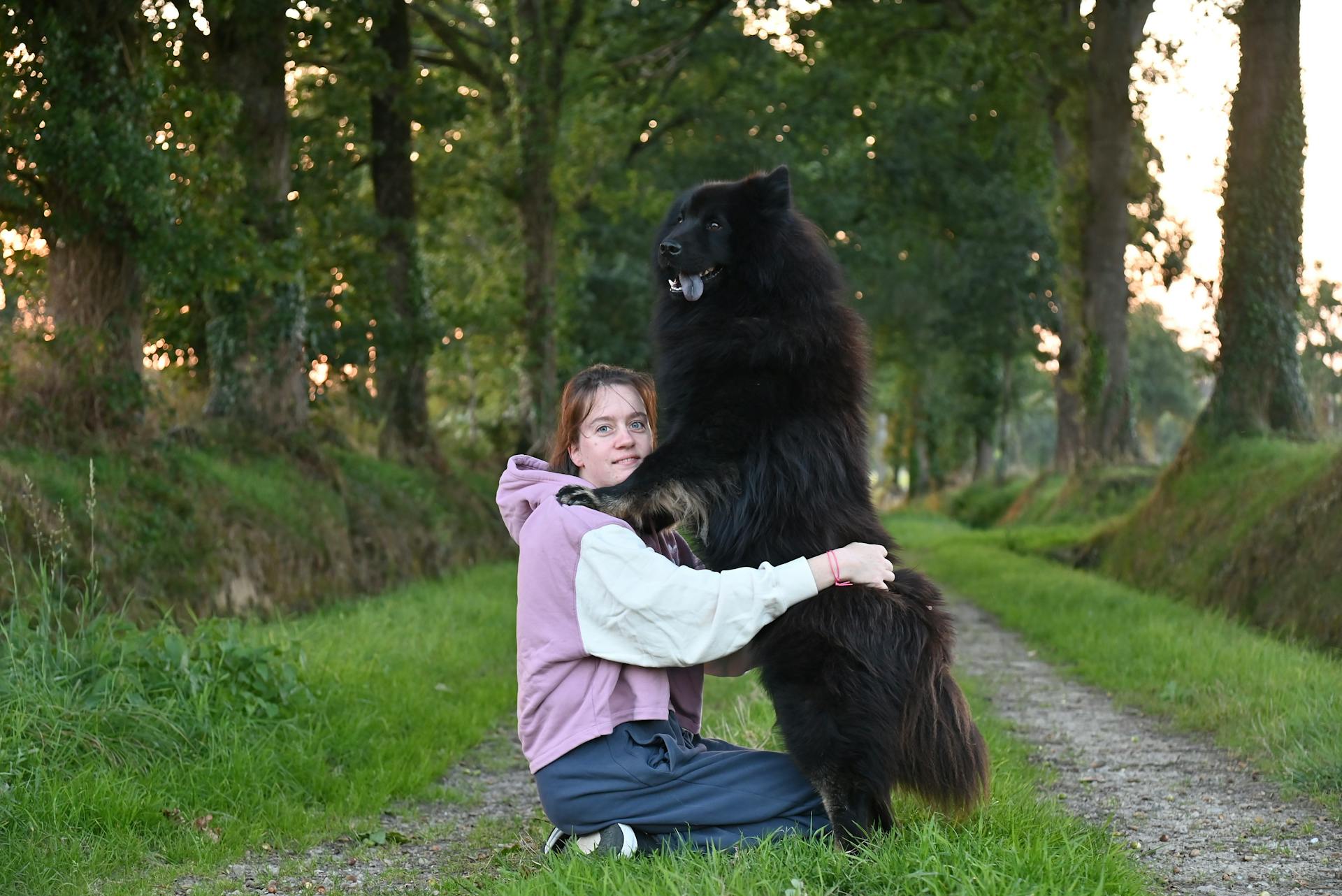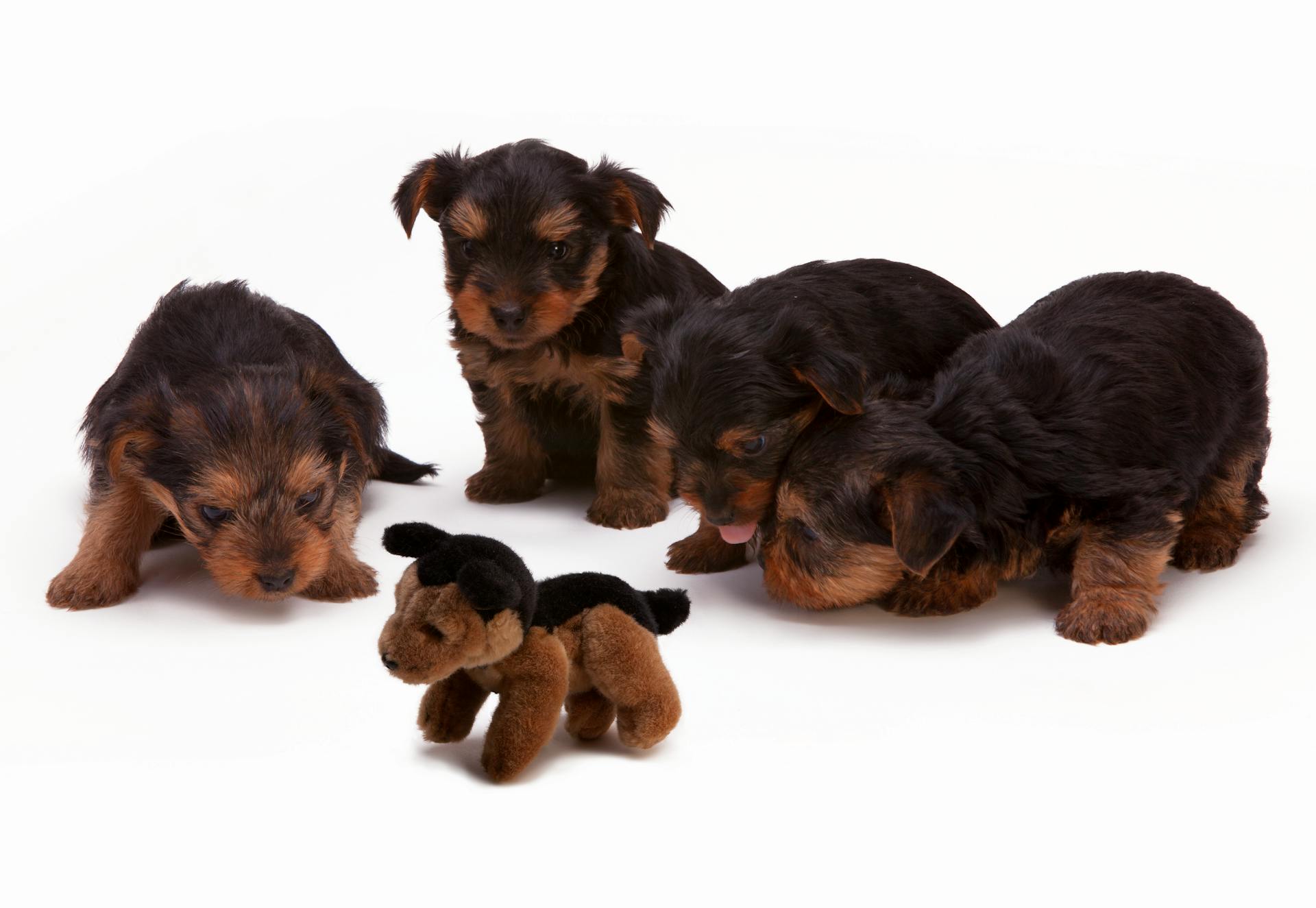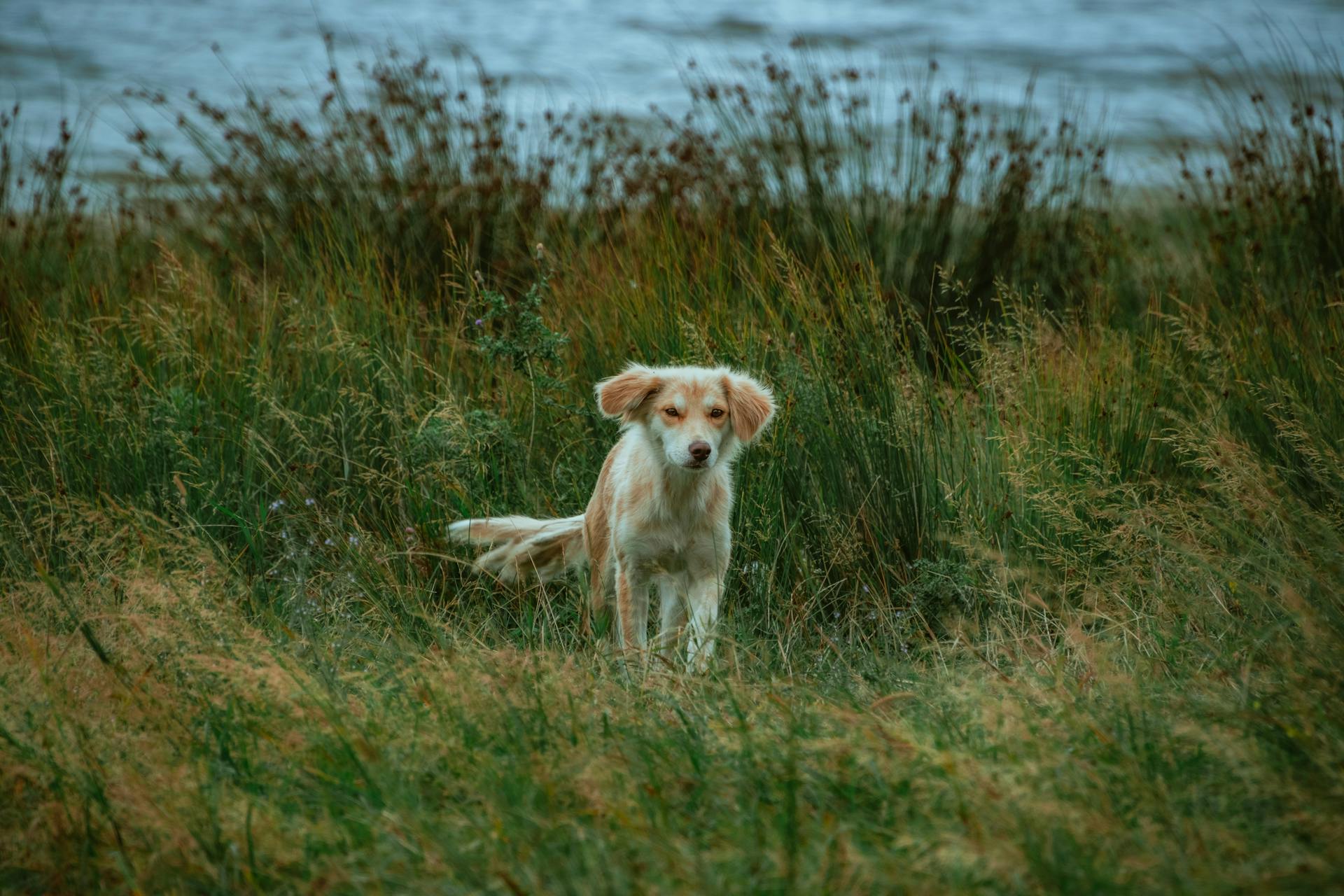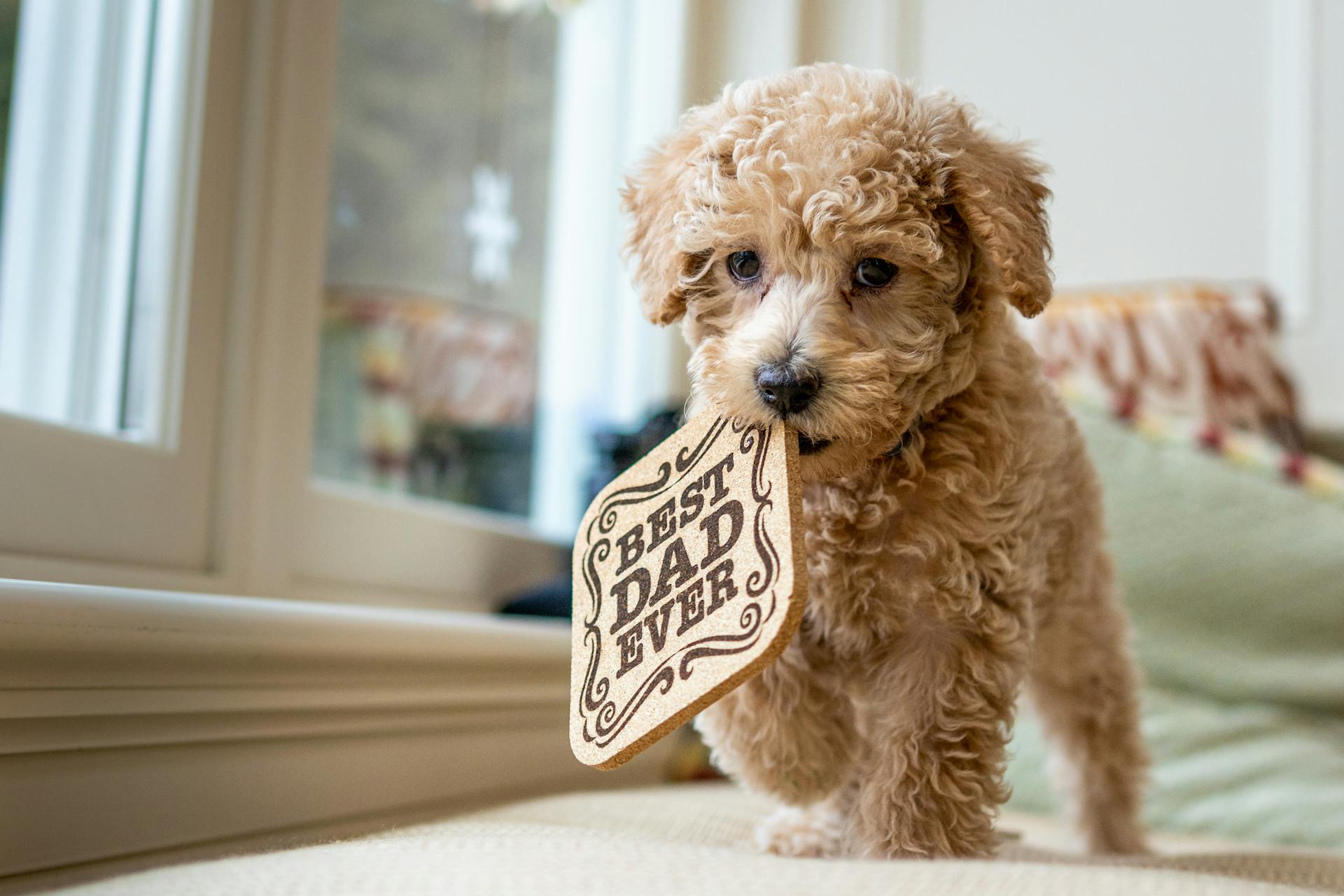
Finding a reputable Neapolitan Mastiff breeder can be a daunting task, especially with so many options available. Look for breeders who are registered with the American Kennel Club (AKC) or the United Kennel Club (UKC).
A good Neapolitan Mastiff breeder will have a clear understanding of the breed's history and characteristics. They should be able to provide you with information on the dog's temperament, size, and potential health issues.
Neapolitan Mastiffs are a rare breed, and finding a breeder who specializes in them can be challenging. However, with patience and persistence, you can find a reputable breeder who will help you find your perfect companion.
History and Origins
The Neapolitan Mastiff has a rich history that spans thousands of years. The breed's ancestors date back to 5,000 years ago in Tibet, where massive dogs were used in battle and as guards.
The Neapolitan Mastiff was developed in southern Italy, specifically in the vicinity of Naples, from which they take their name. They were bred to be massive in size with heavy, loose skin that would protect them in case of attack.
Recommended read: Massive Mastiffs
The breed's origins can be traced back to the Roman Empire, where they were used as guards and companions. They were also known as the "Molossus" breed, which was crossed with other large breeds to create the mastino.
The Neapolitan Mastiff was first recognized by the international dog registry, the Federation Cynologique Internationale (FCI), in 1949. This marked a significant milestone in the breed's history, as it gained international recognition.
The first Neapolitan Mastiffs were imported to the United States in the 1970s, with the first known import being in 1973. The breed quickly gained popularity in Europe and eventually made its way to America.
The American Kennel Club recognized the Neapolitan Mastiff in 2004, adding to the breed's growing popularity. Today, the Neapolitan Mastiff is a beloved breed around the world, known for its loyalty and protective nature.
Size and Physical Characteristics
The Neapolitan Mastiff is a massive breed with a unique appearance. They stand between 24 to 31 inches tall at the shoulder.
Males typically weigh between 150 to 200 pounds, while females weigh between 120 to 175 pounds. Some dogs can be smaller or larger than average.
Their stocky body is covered in loose skin, which is a natural defense mechanism that helps protect them from bites and scratches. This loose skin also helps regulate their body temperature.
Here are the average height and weight ranges for Neapolitan Mastiffs:
Breed Group
If you're wondering about your dog's breed group, you can check out Wisdom Panel's DNA tests.
Breed groups can be a great way to understand your dog's ancestry and characteristics.
The Neapolitan Mastiff, for example, is a large and powerful breed that can be identified through a DNA test.
This breed group can help you understand your dog's size and physical characteristics.
Size
The Neapolitan Mastiff is a large breed, and its size can vary slightly depending on whether it's a male or female. Males stand 26 to 31 inches at the shoulder.

Females are slightly smaller, standing 24 to 29 inches tall. Some dogs can be smaller or larger than average.
Here's a breakdown of the average height and weight for Neapolitan Mastiffs:
As you can see, males are generally taller and heavier than females. But remember, every dog is unique, and some may be smaller or larger than average.
Distinctive Physical Traits
The Neapolitan Mastiff is a massive dog with a stocky body and loose skin. Their immense size can be intimidating, but it's also part of their charm.
Their faces are a key feature of this breed, with an abundance of wrinkles and folds hanging from the muzzle, nose, and face. These wrinkles are a result of focused breeding in the 1900s.
The ears are long and flanked on either side of the head, adding to the overall rugged appearance of this dog. The loose skin and wrinkles can make them look a bit droopy, but it's all part of their unique charm.
Their coats come in a variety of colors, including blue, black, mahogany, and tawny, with lighter and darker shades possible.
Coat Color and Grooming
The Neapolitan Mastiff's coat is a beautiful sight to behold, coming in a variety of colors including solid gray, black, mahogany, and tawny, as well as tan brindle with dark stripes.
Their short, dense coat is relatively low maintenance, requiring only weekly brushing with a bristle brush or hound glove to keep it clean and free of loose hair.
A bath is only needed as needed, and be prepared to get wet when you do, as they have a thick and abundant body skin.
The face of the Neapolitan Mastiff is a unique feature, with heavy, velvety wrinkles and folds that extend from the eyelids to the dewlap, and from under the lower lids to the outer edges of the lips.
Cleaning and keeping these wrinkles dry are crucial parts of grooming this breed, so be sure to introduce your Neo to being brushed and examined from an early age.
Regular nail trimming, ear cleaning, and teeth brushing are also essential for maintaining your Neapolitan Mastiff's overall health and wellbeing.
Their droopy jowls make them prone to drooling, so be prepared for a slobbery mess, especially during mealtime, and have a few towels handy to clean up any spills.
3 Little-Known Facts

The average height of an adult is around 5 feet 9 inches, but did you know that the shortest adult in recorded history was a woman named He Pingping, who stood at just 74.6 cm (2 feet 5.3 inches) tall?
The human nose can detect over 1 trillion different scents, which is more than the number of stars in the Milky Way galaxy. This is due to the hundreds of different types of olfactory receptors in our noses.
Our eyes are capable of seeing a vast range of colors, but did you know that the human eye can also detect the polarization of light, which is why we can see the glare on a wet road or the reflection off a CD?
Temperament & Intelligence
The Neapolitan Mastiff is a breed that's as laid-back as it is intimidating, often described as sweet and sometimes downright lazy. They're mildly affectionate, but love to be with their people, often singling out one family member as their favorite person.
Despite their gentle nature, Neapolitan Mastiffs are highly protective of their family and will stand in the way of any perceived threat. They're not afraid to fight without hesitation and refuse to back down.
Early socialization is crucial for Neapolitan Mastiffs, as they can be aggressive towards other dogs and people if not taught manners. This is why enrolling in puppy socialization classes and exposing them to various experiences, sights, and sounds is essential.
Neapolitan Mastiffs are strong-willed and need a confident trainer who uses positive reinforcement techniques. Physical punishment is never an option, but firm and consistent training is necessary to establish good habits.
Housetraining shouldn't be a problem if you make it a positive experience and provide a regular potty schedule. Crate training is also a great tool for housetraining and keeping your young puppy from chewing things they shouldn't.
Neapolitan Mastiffs are loyal and peaceful dogs, making them excellent family pets. However, their size requires careful supervision around children, and they may not get along well with other dogs due to their intimidating size.
Here's an interesting read: Neapolitan Mastiff Puppy
Care and Maintenance
Neapolitan mastiffs require less exercise than other working breeds, but still need plenty of training and grooming care to be healthy, well-mannered companions at home.
Their short, wrinkly coats need weekly brushing with a bristle brush or hound glove to keep them clean and free of loose or dead hair. This will also help with shedding, which is about average for a dog.
Bathe your Neapolitan mastiff as needed, but be prepared to get wet - they can be quite messy! Their body skin is thick and abundant, and their short, dense coat is the same length and smoothness all over the body.
Cleaning and keeping the wrinkles dry are crucial parts of grooming this breed. Introduce your Neapolitan mastiff to being brushed and examined when they're a puppy to make grooming a positive experience.
Food & Diet
Neapolitan Mastiffs need high-quality large or giant-breed dog food to support their slow and steady growth.
Their large-boned and sizeable bodies take up to 3 years to finish growing, so formulas that don't speed their development are essential.
A good rule of thumb is to feed your Neapolitan Mastiff several smaller portions throughout the day to prevent bloat, which is a common issue in giant breeds.
You should aim to feed your adult Neapolitan Mastiff 6-8 cups of dry food daily, but this may vary depending on their individual needs and activity level.
To ensure your dog is at a healthy weight, measure their food portions and consider treats when tracking their daily calorie intake.
Care
Neapolitan Mastiffs are relatively laid-back and don't require as much exercise as other working breeds.
Their short, wrinkly coats need regular grooming to stay healthy and well-mannered.
Weekly brushing with a bristle brush or hound glove will keep their coat clean and free of loose or dead hair.
You should also bathe them as needed, but be prepared to get wet.

The Neapolitan Mastiff's face is made up of heavy, velvety wrinkles that need to be cleaned and kept dry to prevent skin irritation and infections.
Cleaning and keeping the wrinkles dry are important parts of grooming this breed.
You should introduce your Neapolitan Mastiff to being brushed and examined when they're a puppy to make grooming a positive experience.
Regular nail trimming, ear cleaning, and teeth brushing will also enhance their overall health and wellbeing.
Because of their droopy jowls, many owners keep a slobber rag handy to clean up excess saliva.
A bath from time to time should be enough to keep their short coat clean and well-maintained.
You should also check and gently clean their eyes and ears whenever needed, and trim their nails regularly to keep them at a short length.
As a Neapolitan Mastiff owner, you'll need to be prepared for their tendency to drool, especially during mealtime.
Keeping a few towels handy throughout the house will help you clean up quickly when needed.
Health and Wellness
The Neapolitan Mastiff is a breed known for its loyalty and protective nature, but like all breeds, it's not immune to health issues.
Hip and elbow dysplasia are common conditions in Neapolitan Mastiffs, caused by a malformation in the joints as they age, leading to weakness and pain. This can be a concern due to the breed's large size, as their joints are carrying a lot of weight.
A reputable breeder will be honest and open about health problems in the breed and the incidence with which they occur in her lines. They should be able to provide evidence that a puppy's parents have OFA or PennHIP clearances for hips and elbows.
Neapolitan Mastiffs are also prone to eye problems, such as cherry eye, entropion, and ectropion, which can be painful and affect their vision.
Gastric dilatation-volvulus (GDV or bloat) is a life-threatening condition that can occur when gases build up inside the stomach and cause it to twist. This is a high-risk condition that requires prompt veterinary attention.
Discover more: Neapolitan Mastiff Health
Here are some common health issues in Neapolitan Mastiffs, along with their risk profiles and estimated costs to diagnose and treat:
Skin allergies and skin fold dermatitis are also common issues in Neapolitan Mastiffs, due to their skin folds and drooping skin. Regular grooming and attention to their skin health can help prevent these problems.
Training and Behavior
Training your Neapolitan mastiff should begin as soon as possible, preferably during puppyhood at about 8 weeks of age.
Socialization training is key for Neapolitan mastiffs, as they are wary of strangers and naturally suspicious of outsiders. This is crucial to help them learn to welcome guests appropriately and distinguish between friend and foe.
Neapolitan mastiffs respond well to positive reinforcement with affection and treats to reward good behavior, rather than punishment.
Exercise
Exercise is a crucial aspect of a Neapolitan Mastiff's life, but it's essential to approach it with care.
They don't need a lot of exercise and will avoid injury with a gentle approach to working out.
Walks are sufficient for them, and you should avoid jogs, bike rides, and hikes that might make their heavy bodies too taxing on the joints.
30-45 minutes of exercise is adequate as long as you watch for signs of obesity.
You should also monitor their daily activity around the house, as running up and down stairs or jumping down from a car can overstress their bodies.
Traits and Behavior
Neapolitan Mastiffs can be wary of strangers and naturally suspicious of outsiders, making socialization training key to their development.
Their independent nature can make them stubborn and difficult to train as they get older, so early training is crucial to prevent bad habits from forming.
Training should begin as soon as possible, preferably during puppyhood at about 8 weeks of age, to get on top of things before they become too set in their ways.
Neapolitan Mastiffs respond well to positive reinforcement with affection and treats to reward good behavior, rather than punishment.
Reward-based training techniques are effective, and praise is an essential part of their training process.
They thrive on predictable routines and consistent feedback, which helps maintain control of the training process.
Neapolitan Mastiffs can quickly tire of training, so sessions should be as short as necessary to keep them engaged and eager to please.
They are sensitive dogs, so it's essential to keep training sessions positive and avoid harsh punishment.
Owning a Neapolitan Mastiff
Owning a Neapolitan Mastiff requires a significant investment of time, patience, and money. The price for Neapolitan Mastiff puppies can be high, ranging from $2,500 to $5,000 or more, depending on pedigree and availability.
These dogs are naturally protective and may become agitated if someone tries to muscle in on their territory. Early and ongoing work is essential to promote their tolerance of others.
To help them adapt to regular guests, it's a good idea to have assorted visitors over to provide positive experiences when the dog is young. This can help dull their territorial sense and make them more comfortable around strangers.
Here are some resources to find a reputable breeder:
- Unites States Neapolitan Mastiff Club (USNMC)
- USNMC Breeder Referral
- AKC Neapolitan Mastiff Breeders
Responsible breeders will provide all relevant medical tests for the litter's family and allow you to meet the litter's parents and see the conditions in which their dogs are kept.
Adopt/Buy
Adopting or buying a Neapolitan Mastiff can be a costly endeavor, with prices ranging from $2,500 to $5,000 or more depending on pedigree and availability.
The price tag is just one aspect to consider, as these dogs require special care and attention.
It's unlikely to find Neapolitan Mastiffs in shelters, but your local shelter may have similar breeds available for adoption.
You can also try contacting breed-specific rescues, which can connect you with regional resources.
To find a reputable breeder, research their practices and ask questions about the health and well-being of their dogs.
A responsible breeder will provide medical test results for the litter's family and allow you to meet the parents.
You can find resources like the national breed club and the AKC to help you start your search.
Here are some organizations to consider:
- Unites States Neapolitan Mastiff Club (USNMC)
- USNMC Breeder Referral
- AKC Neapolitan Mastiff Breeders
Owning Essentials
Owning a Neapolitan Mastiff requires a commitment to early and ongoing training to promote their tolerance of others. They can become agitated if someone tries to muscle in on their territory.
Neapolitan Mastiffs are indoor dogs and want to stick by their owner's side. They're naturally protective and may have issues with visitors, especially if they're not socialized from an early age.
Having assorted visitors over to provide positive experiences starting when the dog is young will help them adapt to regular guests and dull their territorial sense. With practice, they can learn to determine who is trustworthy or not.
Neapolitan Mastiffs are trainable, but they can be independent and may ignore a command if it doesn't suit them. Early training is essential to establish a strong bond and set clear rules.
As they mature, they'll have fewer issues with visitors, but consistent practice and socialization are still necessary to maintain their trust and loyalty.
Frequently Asked Questions
How much does a Napolitan mastiff cost?
A Neapolitan Mastiff puppy costs between $3,500-$5,000, plus additional expenses for supplies and veterinary care.
Is Neapolitan Mastiff a good family dog?
Yes, Neapolitan Mastiffs are a great choice for families due to their gentle and loving nature. They make loyal companions for children and adults alike, but their large size requires careful consideration.
What is the life expectancy of a Neapolitan Mastiff?
The average lifespan of a Neapolitan Mastiff is between 7 to 9 years.
Sources
Featured Images: pexels.com


